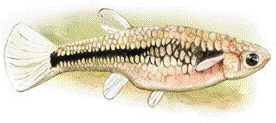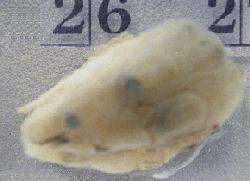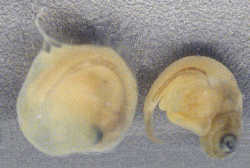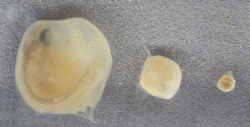Paradigm Shifts and Steve Gould
Bowie MD, November 1, 2026. This is a first for me. I've never datelined a webpage before. I never met Stephen Jay Gould (1942-2002), but for 30 years he was my teacher and mentor, through 20 books and 300 magazine articles. I would love to have seen how he would have handled this story in his column in Natural History magazine. I hope that Carl Zimmer, SJG's worthy successor, picks up this theme and writes about it.
You will find dates at the bottom of all my webpages. They record the time of last updating of the text or when I last checked all the links to make sure that you find something if you click on one. But I'm dating this page so you can look back and check the progress over the next few years that, I promise, is going to take place. I'd wager good money on this one. We are about to learn about the origin of novelty, and how evolution produces a complex organ.
Charles Darwin came close to despair over a couple of issues bearing upon his several theories of evolution. Perhaps the biggest issue to confront him was time; how to demonstrate that deep time, sufficient time to allow for the evolution of all life, had really existed. He called this problem that "odious spectre" hanging over his theory. I have never been certain whether it was time itself that he thought was the odious spectre, or whether he meant Lord Kelvin, who was then considered to be the expert on the age of the Earth. When Kelvin lowered his estimate from 100 to 20 million years, Darwin despaired. The discovery of radiation later disproved Kelvin, but Darwin did not live to taste the sweetness of knowing that evolution has been going on for almost 4 billion years. Science (particularly geology, paleontology and paleoanthropology) underwent a paradigm shift when radiometric dating matured as a methodology and firmly established the age of the Earth at 4.56 ± 0.02 billion years.
Similarly, Darwin was frustrated by his inability to show living physical evidence for the gradual change of species or for the origin of complex organs in nature. The evolution of complex eyes, which he handled effectively by use of analogy, is but one example. (you can read Darwin on the Eye from both 1st and 6th editions of The Origin of Species). Darwin proposed that complex eyes could have been formed with a succession of photosensitive organs, each a bit more complex than its predecessor and each favored by natural selection because of the advantage that accrued to the possessor. Visualizing such a process would be easiest if steps in this sequence were preserved in closely related living organisms; however, no such sequence exists for eyes because the intermediate stages have been lost through extinction. Our best alternative has been to compare distantly related species that display what appear to be intermediate stages in evolution, as was done by Darwin with examples from across the mollusk or arthropod phyla. However, a suitable complex organ has now been found in the genus Poeciliopsis, small fishes known as guppies, topminnows or livebearers.
Placentas, Like Eyes, Are Complex
Fishes are ancient animals. Amphibians, reptiles, birds, mammals -- all the Tetrapods descend from them. Placental reproduction has evolved repeatedly in all these groups. The mammalian placenta has been far better characterized than that of any other placental organism and serves as a model for the complexity of the adaptation. More than 50 genetic loci regulate the development of the placenta while additional adaptations include loci that are members of gene families that produce protein hormones and hemoglobin but are only expressed in the fetus and are specifically adapted to fetal development. Other adaptations include facilitation of gas exchange, the transfer of nutrients, disposal of waste products, and the suppression of immunological interactions or other forms of intergenomic conflict between the mother and embryo. The placenta is also like the eye because it appears that all of these features must be present in order for it to function successfully.
 Gila Topminnow -- Poeciliopsis occidentalis
Gila Topminnow -- Poeciliopsis occidentalis
|

There are more than 25,000 species of fishes living in all the aquatic environments on this planet. You'd think that they had long ago settled every aspect of organic design, perfected in every way for the environments in which they live. But, they can't stop evolving any more than can other plants and animals. Fishes have been tinkering with mating and reproductive systems for over 500,000 years. The Cichlid Fishes provide us with many examples of recent rapid evolution and radiation of species (and of mating systems and behaviors). However, catching a species in the act of organic change is difficult. Speciation, even in "fast" lineages, might take thousands of years, while researchers have careers spanning only a few decades. But the Poeciliids now present us with the opportunity to find out something about how they did it.
The genus Poeciliopsis may be divided into three groups of fishes based upon their reproductive behavior (they are listed below). Remember first that they are livebearers. In all cases in this genus the eggs develop within the mother until the young are ready to be released into the external environment. In some cases the eggs are created with lots of yolk -- enough to last for the entire development of the young prior to their release. Since the mother does not need to feed the young during development, she has no need for a placenta in which to house her eggs. Nine species in the genus employ this reproductive system. This group is shown in black in the Matrotrophy Index, which shows degrees of post-fertilization maternal provisioning, and which is more fully explained below.
Another group of Poeciliids might be called the full placentals. They develop eggs with little food prestored in them. The mother requires a well-developed placenta in which to house all her eggs and into which she must supply food during the period of internal development after fertilization. It is

 also through the placenta that she must arrange for waste removal and gas exchange. Six species in the genus employ this arrangement. They are shown in red in the Matrotrophy Index here and below.
also through the placenta that she must arrange for waste removal and gas exchange. Six species in the genus employ this arrangement. They are shown in red in the Matrotrophy Index here and below.
Finally, we have an intermediate group of five species (blue) with less demanding requirements. They produce somewhat yokey eggs but also need to supply some food during internal development. This group also has intermediate placentas that are less-fully developed in comparison to the obligate placentals. Whether they are in the process of moving toward full placentalship or have settled on an intermediate arrangement has not yet been determined. See the discussion below where the Matrotrophy Index is again presented and explained more fully and more technically.
What is evident though is the fact that, for some species of Poeciliopsis, there has been a paradigm shift with respect to reproductive behavior. The ancestors of these fishes were non-placentals with no need for that complex organ. They simply released eggs into the water and all post-fertilization development took place outside the mother's body. How is it then that their closely related descendent species have come to have a range of novel and complex placental organization? Their genes will help to tell the story. I am willing to bet that, as a result of the work done so far, many scientists will be encouraged to delve into this chance of a lifetime to find out how these fish have changed over time. I am also willing to bet that they will find that relatively small genetic changes are required to produce significant organic and behavioral changes.
Adding Complexity With Superfetation
Now, let's tip the scale of complexity discussed so far. I thank David Reznick for informing me about another feature of these fishes not discussed in the paper in Science. The Poeciliidae have a second variation on the theme of live bearing called superfetation. Females of some species carry more than one brood of young in distinctly different stages of development. As with matrotrophy, superfetation is not simply present or absent. Some species characteristically carry two litters of young in different stages of development. Others can carry three, four or more litters. Species that carry more simultaneously developing litters give birth more frequently to fewer young per litter. Superfetation thus changes the distribution of births over time. To help me describe this process Dr. Reznick has kindly supplied the photos and their descriptions, and some of the more technical narrative on this page.
|



 Placental Evolution in
Placental Evolution in Gila Topminnow -- Poeciliopsis occidentalis
Gila Topminnow -- Poeciliopsis occidentalis




 Poeciliopsis gracilis -- Photo by Jacques Blanc
Poeciliopsis gracilis -- Photo by Jacques Blanc
